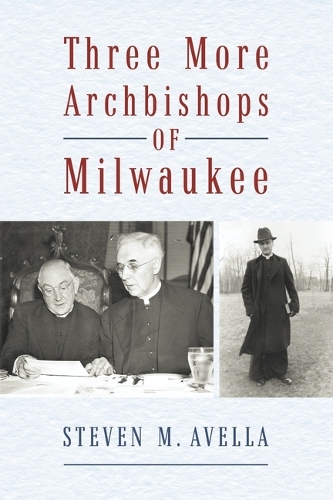
Three More Archbishops of Milwaukee
(Paperback)
Publishing Details
Three More Archbishops of Milwaukee
By (Author) Steven M. Avella
BookBaby
BookBaby
23rd April 2025
United States
Classifications
General
Non Fiction
Physical Properties
Paperback
152
Width 152mm, Height 228mm, Spine 10mm
244g
Description
"Three More Archbishops of Milwaukee" offers an in-depth look at three Catholic archbishops who guided Milwaukee's archdiocese from 1930 to 1958: Samuel A. Stritch, Moses E. Kiley, and Albert G. Meyer. Although each archbishop brought a distinct temperament and leadership style to their role, they shared a foundational education from Roman seminaries, which played a crucial part in shaping their vision and governance.
Samuel A. Stritch, the first U.S.-born archbishop of Milwaukee, arrived as the Great Depression gripped Wisconsin. His leadership focused on stabilizing faltering archdiocesan finances and energizing lay Catholic Action. Stritch's pastoral touch and accessibility endeared him to Milwaukeeans, and his eventual departure for Chicago was widely lamented.
His successor, Moses E. Kiley, a native of Nova Scotia, was a stern and taciturn figure. He focused on planning and rebuilding as Milwaukee prospered after World War II. Kiley's strict rule, particularly with clergy, was accompanied by efforts to rebuild a cathedral and enhance archdiocesan institutions, including the seminary and orphanage.
Albert G. Meyer, who followed Kiley, had extensive ties to Wisconsin, having served as rector of St. Francis Seminary and bishop of Superior. His tenure was marked by rapid expansion of parishes and schools, and he oversaw the largest period of growth in the archdiocese's history. Meyer also confronted challenges brought by the freeway system, suburbanization, and the shifting racial demographics in Milwaukee.
Throughout their terms, all three archbishops brought a Roman-trained, uniform theological vision, providing a sense of continuity to Milwaukee Catholicism during a time of great transformation. Ethnic identities, though still important, began to fade in prominence as suburban life reshaped the community. Despite these shifts, the steady leadership of Stritch, Kiley, and Meyer offered stability and cohesion to Milwaukee Catholics in a period of immense social and institutional change.
Author Bio
Steven M. Avella is a professor emeritus of Marquette University and priest of the Archdiocese of Milwaukee. He has authored several books on the history of Catholicism in Wisconsin, including In the Richness of the Earth: A History of the Archdiocese of Milwaukee 1843-1958, and Confidence and Crisis: A History of the Archdiocese of Milwaukee, 1959-1977, and edited Milwaukee Catholicism: Essays on Church and Community (1991). He has also authored books on the history of Catholic life in Chicago, Sacramento, Reno, Colorado Springs, and Phoenix. Avella has conducted research in the Archives of the Archdioceses of Milwaukee and Chicago, and the Apostolic Vatican Archives. A graduate of the University of Notre Dame (Ph.D., 1985), he studied under the late Professor Philip Gleason. He served as President of the American Catholic Historical Association (2009-2010).
